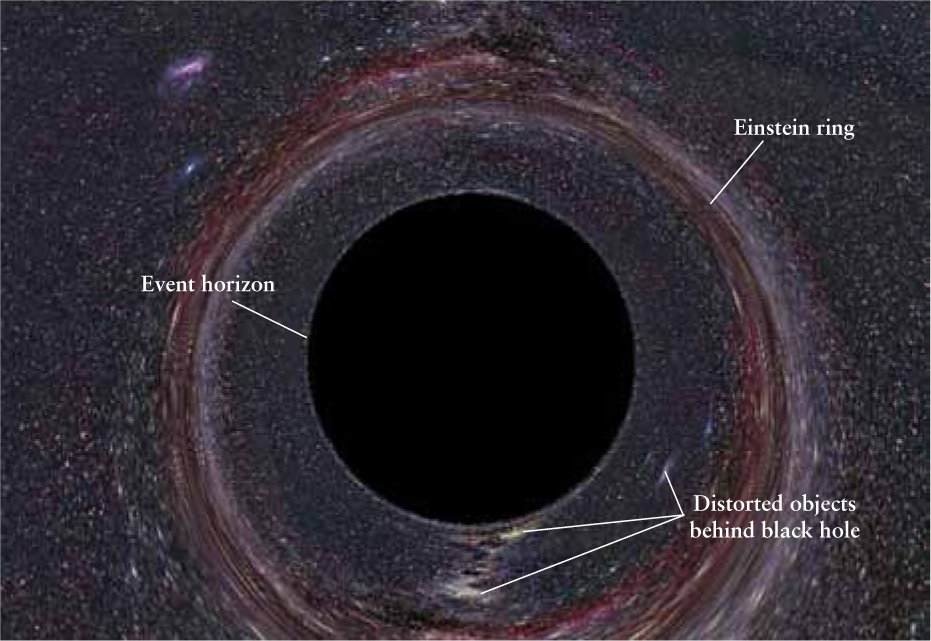21-8 Falling into a black hole is an infinite voyage
 Imagine that you are on board a spaceship at a safe distance from a 5-M⊙ black hole. A distance of 1000 Schwarzschild radii, or 15,000 km, would suffice. You now release a space probe with a video camera and let it fall into the black hole. What will you see on the video as the probe falls?
Imagine that you are on board a spaceship at a safe distance from a 5-M⊙ black hole. A distance of 1000 Schwarzschild radii, or 15,000 km, would suffice. You now release a space probe with a video camera and let it fall into the black hole. What will you see on the video as the probe falls?
The gravitational field of a black hole distorts the image of other stars
Initially, at 1000 Schwarzschild radii from the black hole, the video camera would send back a rather normal view of space. But as the probe approaches the black hole, the bending of light by the black hole becomes more pronounced (Figure 21-20). Light rays passing close to the back hole are deflected so much that background stars are severely distorted. For the black hole in Figure 21-20, light from a bright object directly behind the black hole is warped into a feature called an “Einstein ring.”

How will the probe itself look from your vantage point on the spaceship at a safe distance? To discuss changes in the probe, let’s assume it emits blue light, and it has a clock that was initially synchronized with a clock on your spaceship (Figure 21-21). You might expect that as the probe falls, its speed should continue to increase. This expectation is true up to a point. But as the probe approaches the event horizon, where the black hole’s gravity is extremely strong, the gravitational slowing of time becomes so pronounced that the probe will appear to slow down! From your point of view on the spaceship, the probe takes an infinite amount of time to reach the event horizon, where it will appear to remain suspended for all eternity. You can see the slower passage of time by comparing the clocks on the spaceship to the clocks on the probe in Figure 21-21.

To watch these effects, however, you will need special equipment. The reason for this is the gravitational redshift: As the probe falls, the light reaching you from the probe is shifted to longer and longer wavelengths. The probe’s blue light will turn green, then yellow, then red, and eventually fade into infrared wavelengths that your unaided eye cannot detect. Therefore, while the object appears to never cross the event horizon to an outside observer, any light emitted by the object still disappears from view.
If you could view the falling probe with goggles that tracked light of ever-increasing wavelengths, you would see it come to an unpleasant end. Near the event horizon, the strength of the black hole’s gravity increases dramatically as the probe moves just a short distance closer to the hole. In fact, the side of the probe nearest the black hole feels a much stronger gravitational pull than the side opposite the hole. These tidal forces are like those that the Moon exerts on Earth (see Section 4-8), but are tremendously stronger. Furthermore, the sides of the probe are pulled together, since the hole’s gravity makes them fall in straight lines aimed at the center of the hole. The net effect is that the probe will be stretched out along the line pointing toward the hole, and squeezed together along the perpendicular directions. The stretching—sometimes called spaghettification—is so great that it can rip even the strongest materials apart.
Someone foolhardy enough to ride along with the probe would have a very different view of the fall than your view from the spaceship. From the point of view while riding the probe, there is no slowing of time. The probe and rider experience spaghettification and continue to pass through the event horizon into the singularity.
The size of the black hole matters: Tidal forces causing spaghettification are greater for smaller black holes. For stellar-mass black holes (like the 5-M⊙ black hole considered here), tidal forces would squeeze and stretch a person to death even before they reach the event horizon. However, a person could fall right through the event horizon of a supermassive black hole, with tidal forces only pulling them apart closer to the center. Therefore, a person really could see what is inside a supermassive black hole, but at great cost for they could never share what they learned.
CONCEPT CHECK 21-15
If a person fell into a black hole feet first, would they feel a strong tidal force pulling on their feet before crossing the event horizon?
Maybe, as it depends on the mass of the black hole. For a supermassive black hole with weak tidal forces, they would not notice their feet being tugged with a greater force than any other part of their body. However, for a stellar-mass black hole, their feet could be pulled relative to their legs by deadly forces.